Effect of Climate Variability on Green and Blue Water Resources in a Temperate Monsoon Watershed, Northeastern China
Abstract
:1. Introduction
2. Materials and Methods
2.1. Study Area
2.2. Data
2.3. SWAT Model Data Preparation
2.4. SWAT Model Evaluation Index
2.5. Water Resource Statistics
2.6. Abrupt Change Point Detection
3. Results
3.1. SWAT Model Construction, Calibration, and Validation
| Parameter Name and Document Type a | Description b | Initial Range c | Calibrated Value |
|---|---|---|---|
| v_SLSUBBSN.hru | Average slope length (m) | −20% to +20% | Increased to 11.971% |
| v_CANMX.hru | Maximum canopy storage | 0–100 | 18.780 |
| r_CN2.mgt | SCS curve number for moisture condition II | −20% to +20% | Decreased to 0.027% |
| r_SOL_K().sol | Saturated hydraulic conductivity (mm h−1) | −20% to +20% | Increased to 0.173% for the first layer |
| v_ESCO.hru | Soil evaporation compensation factor | 0–1 | 0.952 |
| v_EPCO.hru | Plant uptake compensation factor | 0–1 | 0.341 |
| v_CH_N2.rte | Manning “n” value for the primary channel | 0.01–0.3 | 0.146 |
| v_RCHRG_DP.gw | Deep aquifer percolation fraction | 0–1 | 0.132 |
| v_GWQMN.gw | Threshold depth of water in the shallow aquifer required for return flow to occur (mm H2O) | 0–5000 | 1.669 |
| r_SOL_AWC().sol | Available soil water capacity (mm H2O mm−1 soil) | −20% to +20% | Increased to 0.084% for the first layer |
3.2. Variance Tendency of Green and Blue Water Resources from 1970 to 2015
3.3. Effect of Climate Variability on Green and Blue Water Resources in Tanghe River Basin
4. Discussion
5. Conclusions
- (1)
- At the Erdaohezi hydrologic station, the ENS was 0.79 and the R2 was 0.79 in the calibration period and 0.72 and 0.72 in the validation period, respectively. At the Haojiadian hydrologic station, the ENS was 0.74 and the R2 was 0.81 in the calibration period and 0.64 and 0.74 in the validation period, respectively. The model simulations of the two hydrological stations were extremely precise, indicating that the model can accurately describe basic watershed hydrologic cycle processes.
- (2)
- From 1970 to 2015, the average amount of annual water resources in the Tanghe River Basin was 759.37 mm, that of green water resources was 516.83 mm, and that of blue water resources was 242.55 mm. The average annual green water coefficient was 68%, and the average amount of annual green water resources was 2.13 times that of the blue water resources. The amount of green water storage, green water resources, and blue water resources all demonstrated an insignificant downward trend.
- (3)
- From 1970 to 2015, the precipitation, green water resources, and blue water resources in the Tanghe Basin all experienced an abrupt change in 1976. Compared with that of the reference period, the average annual precipitation and green and blue water resources in the variation period decreased by 64.01, 78.48, and 35.94 mm/year, and their change rates were −8.38%, −13.45%, and −13.17%, respectively.
- (4)
- The spatial distributions of green and blue water resources and the precipitation RCR were similar, with high values in the south and low values in the north. Additionally, the RCRs of the green and blue water were all negative except for those in a small part upstream of the Tanghe Basin. These results indicate that precipitation greatly impacts green and blue water resources, and the influence of climate change in the region was significant.
Author Contributions
Funding
Data Availability Statement
Conflicts of Interest
References
- Oki, T.; Kanae, S.; Musiake, K. Global Hydrological Cycles and World Water Resources. Science 2006, 313, 1068–1072. [Google Scholar] [CrossRef] [Green Version]
- Leta, O.T.; Bauwens, W. Assessment of the Impact of Climate Change on Daily Extreme Peak and Low Flows of Zenne Basin in Belgium. Hydrology 2018, 5, 38. [Google Scholar] [CrossRef] [Green Version]
- Mohammed, K.; Islam, A.K.M.S.; Islam, G.M.T.; Alfieri, L.; Bala, S.K.; Khan, J.U. Impact of High-End Climate Change on Floods and Low Flows of the Brahmaputra River. J. Hydrol. Eng. 2017, 22, 04017041. [Google Scholar] [CrossRef]
- Habel, S.; Fletcher, C.H.; Rotzoll, K.; El-Kadi, A.I. Development of a model to simulate groundwater inundation induced by sea-level rise and high tides in Honolulu, Hawaii. Water Res. 2017, 114, 122–134. [Google Scholar] [CrossRef]
- Zang, C.F.; Liu, J.; van der Velde, M.; Kraxner, F. Assessment of spatial and temporal patterns of green and blue water flows under natural conditions in inland river basins in Northwest China. Hydrol. Earth Syst. Sci. 2012, 16, 2859–2870. [Google Scholar] [CrossRef] [Green Version]
- Malin, F. Freshwater as shared between society and ecosystems: From divided approaches to integrated challenges. Philos. Trans. R. Soc. B Biol. Sci. 2003, 358, 2037–2049. [Google Scholar]
- Falkenmark, M. Land-Water Linkages: A Synopsis. In Land and Water Bulletin: Land and Water Integration and River Basin Management; Mather, T., Ed.; Food and Agriculture Organization (FAO) of the United Nations: Rome, Italy, 1995; pp. 15–16. [Google Scholar]
- Wu, H.; Wu, C.; Hao, F.; Jin, Y. Research on Assessment and Management of Green Water. China Popul. Resour. Environ. 2008, 18, 61–67. [Google Scholar]
- Liu, J.; Yang, H. Spatially explicit assessment of global consumptive water uses in cropland: Green and blue water. J. Hydrol. 2009, 384, 187–197. [Google Scholar] [CrossRef]
- Liu, J.; Zehnder, A.J.B.; Yang, H. Global consumptive water use for crop production: The importance of green water and virtual water. Water Resour. Res. 2009, 45. [Google Scholar] [CrossRef] [Green Version]
- Lyu, L.; Wang, X.; Sun, C.; Ren, T.; Zheng, D.-F. Quantifying the Effect of Land Use Change and Climate Variability on Green Water Resources in the Xihe River Basin, Northeast China. Sustainability 2019, 11, 338. [Google Scholar] [CrossRef] [Green Version]
- Liang, J.; Liu, Q.; Zhang, H.; Li, X.; Qian, Z.; Lei, M.; Li, X.; Peng, Y.; Li, S.; Zeng, G. Interactive effects of climate variability and human activities on blue and green water scarcity in rapidly developing watershed. J. Clean. Prod. 2020, 265, 121834. [Google Scholar] [CrossRef]
- Cheng, G. Green Water and Its Research Progresses. Adv. Earth Sci. 2006, 3, 221–227. (In Chinese) [Google Scholar]
- Khoi, D.N.; Nguyen, V.T.; Sam, T.T.; Nhi, P.T.T.; Khoi, D.N. Evaluation on Effects of Climate and Land-Use Changes on Streamflow and Water Quality in the La Buong River Basin, Southern Vietnam. Sustainability 2019, 11, 7221. [Google Scholar] [CrossRef] [Green Version]
- Lemann, T.; Roth, V.; Zeleke, G.; Subhatu, A.; Kassawmar, T.; Hurni, H. Spatial and Temporal Variability in Hydrological Responses of the Upper Blue Nile basin, Ethiopia. Water 2018, 11, 21. [Google Scholar] [CrossRef] [Green Version]
- Schuol, J.; Abbaspour, K.C.; Yang, H.; Srinivasan, R.; Zehnder, A.J.B. Modeling blue and green water availability in Africa. Water Resour. Res. 2008, 44, W07406. [Google Scholar] [CrossRef] [Green Version]
- Schuol, J.; Abbaspour, K.C.; Srinivasan, R.; Yang, H. Estimation of freshwater availability in the West African sub-continent using the SWAT hydrologic model. J. Hydrol. 2008, 352, 30–49. [Google Scholar] [CrossRef]
- Faramarzi, M.; Abbaspour, K.C.; Vaghefi, S.A.; Farzaneh, M.R.; Zehnder, A.J.; Srinivasan, R.; Yang, H. Modeling impacts of climate change on freshwater availability in Africa. J. Hydrol. 2013, 480, 85–101. [Google Scholar] [CrossRef]
- Abbaspour, K.C.; Rouholahnejad, E.; Vaghefi, S.; Srinivasan, R.; Yang, H.; Kløve, B. A continental-scale hydrology and water quality model for Europe: Calibration and uncertainty of a high-resolution large-scale SWAT model. J. Hydrol. 2015, 524, 733–752. [Google Scholar] [CrossRef] [Green Version]
- Yuan, Z.; Xu, J.; Wang, Y. Historical and future changes of blue water and green water resources in the Yangtze River source region, China. Theor. Appl. Clim. 2019, 138, 1035–1047. [Google Scholar] [CrossRef]
- Yuan, Z.; Xu, J.; Meng, X.; Meng, X.; Yan, B.; Hong, X. Impact of Climate Variability on Blue and Green Water Flows in the Erhai Lake Basin of Southwest China. Water 2019, 11, 424. [Google Scholar] [CrossRef] [Green Version]
- Zang, C. Spatial and temporal variability of blue/green water flows in typical meteorological years in an inland river basin in China. J. Water Clim. Chang. 2017, 8, 165–176. [Google Scholar] [CrossRef]
- Food and Agriculture Organization of the United Nations (FAO); International Institute for Applied Systems Analysis. China Soil Map Based Harmonized World Soil Database (HWSD) (v1.1) (2009); National Tibetan Plateau Data Center: Beijing, China, 2019. [Google Scholar]
- Al-Khafaji, M.S.A.; Saeed, F.H.; Al-Ansari, N. The Interactive Impact of Land Cover and DEM Resolution on the Accuracy of Computed Streamflow Using the SWAT Model. Water Air Soil Pollut. 2020, 231, 1–17. [Google Scholar] [CrossRef]
- Jakada, H.; Chen, Z. An approach to runoff modelling in small karst watersheds using the SWAT model. Arab. J. Geosci. 2020, 13, 318. [Google Scholar] [CrossRef]
- Zhang, Z.; Chen, S.; Wan, L.; Cao, J.; Zhang, Q.; Yang, C. The effects of landscape pattern evolution on runoff and sediment based on SWAT model. Environ. Earth Sci. 2021, 80, 1–12. [Google Scholar] [CrossRef]
- Luo, R.; Xu, Z.; Cheng, L. Application of SWAT Model in the Sanchuan River Catchment. J. Water Resour. Water Eng. 2008, 19, 28–33. (In Chinese) [Google Scholar]
- Du, X.; Shrestha, N.K.; Wang, J. Assessing climate change impacts on stream temperature in the Athabasca River Basin using SWAT equilibrium temperature model and its potential impacts on stream ecosystem. Sci. Total. Environ. 2018, 650, 1872–1881. [Google Scholar] [CrossRef]
- Zuo, D.; Xu, Z.; Peng, D.; Song, J.; Cheng, L.; Wei, S.; Abbaspour, K.C.; Yang, H. Simulating spatiotemporal variability of blue and green water resources availability with uncertainty analysis. Hydrol. Process. 2015, 29, 1942–1955. [Google Scholar] [CrossRef]
- Jiang, B. Study on the Change of Lake Water Inflow and Lake Level in Qinghai Lake Based on SWAT Model. Master’s Thesis, China University of Geosciences, Beijing, China, 2018. [Google Scholar]
- Shrestha, N.K.; Du, X.; Wang, J. Assessing climate change impacts on fresh water resources of the Athabasca River Basin, Canada. Sci. Total. Environ. 2017, 601–602, 425–440. [Google Scholar] [CrossRef]
- Pandey, B.K.; Khare, D.; Kawasaki, A.; Mishra, P.K. Climate Change Impact Assessment on Blue and Green Water by Coupling of Representative CMIP5 Climate Models with Physical Based Hydrological Model. Water Resour. Manag. 2019, 33, 141–158. [Google Scholar] [CrossRef]
- Jha, M. SWAT: Model use, calibration, and validation. Trans. Asabe 2012, 55, 1345–1352. [Google Scholar]
- Nilawar, A.P.; Waikar, M.L. Impacts of climate change on streamflow and sediment concentration under RCP 4.5 and 8.5: A case study in Purna river basin, India. Sci. Total. Environ. 2019, 650, 2685–2696. [Google Scholar] [CrossRef]
- Meng, Y.; Zhou, L.; He, S.; Lu, C.; Wu, G.; Ye, W.; Ji, P. A heavy metal module coupled with the SWAT model and its preliminary application in a mine-impacted watershed in China. Sci. Total Environ. 2018, 613–614, 1207–1219. [Google Scholar] [CrossRef] [PubMed]
- Moriasi, D.N.; Arnold, J.G.; Van Liew, M.W.; Bingner, R.L.; Harmel, R.D.; Veith, T.L. Model Evaluation Guidelines for Systematic Quantification of Accuracy in Watershed Simulations. Trans. ASABE 2007, 50, 885–900. [Google Scholar] [CrossRef]
- Muyibul, Z.; Shi, Q.; Muhtar, P.; Zhang, R. Land use and climate change effects on runoff in the upper Urumqi River watershed: A SWAT model based analysis. Acta Ecol. Sin. 2018, 38, 5149–5157. (In Chinese) [Google Scholar]
- Lyu, L.; Wang, X.; Jiang, Y.; Sun, C. Research on spatial and temporal distribution features of green and blue water in Dongjiang River Basin based on SWAT model. Water Resour. Prot. 2017, 33, 53–60. (In Chinese) [Google Scholar]
- Lyu, L.; Wang, X.; Sun, C.; Zhang, J. Study on the Spatiotemporal Variations of Blue and Green Water Resources in Xi River Basin Using the SWAT Moder. Resour. Environ. Yangtze Basin 2019, 28, 39–47. (In Chinese) [Google Scholar]
- Yue, S.; Pilon, P.; Cavadias, G. Power of the Mann–Kendall and Spearman’s rho tests for detecting monotonic trends in hydrological series. J. Hydrol. 2002, 259, 254–271. [Google Scholar] [CrossRef]
- Burn, D.H.; Elnur, M.A.H. Detection of hydrologic trends and variability. J. Hydrol. 2002, 255, 107–122. [Google Scholar] [CrossRef]
- Xue, D.; Zhou, J.; Zhao, X.; Liu, C.; Wei, W.; Yang, X.; Li, Q.; Zhao, Y. Impacts of climate change and human activities on runoff change in a typical arid watershed, NW China. Ecol. Indic. 2021, 121, 107013. [Google Scholar] [CrossRef]
- Wang, Q.; Liu, R.; Men, C.; Guo, L.; Miao, Y. Temporal-spatial analysis of water environmental capacity based on the couple of SWAT model and differential evolution algorithm. J. Hydrol. 2019, 569, 155–166. [Google Scholar] [CrossRef]
- Khalid, K.; Ali, M.F.; Rahman, N.F.A.; Othman, Z.; Bachok, M.F. Calibration Assessment of the Distributed Hydrologic Model Using SWAT-CUP; Springer: Berlin, Germany, 2018. [Google Scholar]
- Du, L.; Rajib, A.; Merwade, V. Large scale spatially explicit modeling of blue and green water dynamics in a temperate mid-latitude basin. J. Hydrol. 2018, 562, 84–102. [Google Scholar] [CrossRef]
- Guo, S.; Zhu, Z.; Lyu, L. Effects of Climate Change and Human Activities on Soil Erosion in the Xihe River Basin, China. Water 2018, 10, 1085. [Google Scholar] [CrossRef] [Green Version]
- Pan, D.; Ren, L. Application of Distributed Hydrological Model in Irrigation Management of Tuhai-Majia River Basin I. Parameter Calibration and Validation. Sci. Agric. Sin. 2012, 45, 471–479. [Google Scholar]
- Neitsch, S.L.; Arnold, J.; Kiniry, J.; Williams, J. Soil & Water Assessment Tool the Oretical Documentation Version 2009; Texas A&M University System: College Station, TX, USA, 2011. [Google Scholar]
- Chen, Y.; Marek, G.W.; Marek, T.H.; Porter, D.O.; Brauer, D.K.; Srinivasan, R. Simulating the effects of agricultural production practices on water conservation and crop yields using an improved SWAT model in the Texas High Plains, USA. Agric. Water Manag. 2021, 244, 106574. [Google Scholar] [CrossRef]
- Feng, X.; Zhang, G. Assessment of Water Resources in Wuyuer River Basin Based on Hydrological Model. J. China Hydrol. 2015, 35, 49–52. [Google Scholar]
- Rong, K.; Chen, X.; Li, Z.; Li, X. Estimating Green and Blue Water Resources in Xixi Watershed of Jinjiang Basin. Bull. Soil Water Conserv. 2011, 31, 12–15. [Google Scholar]
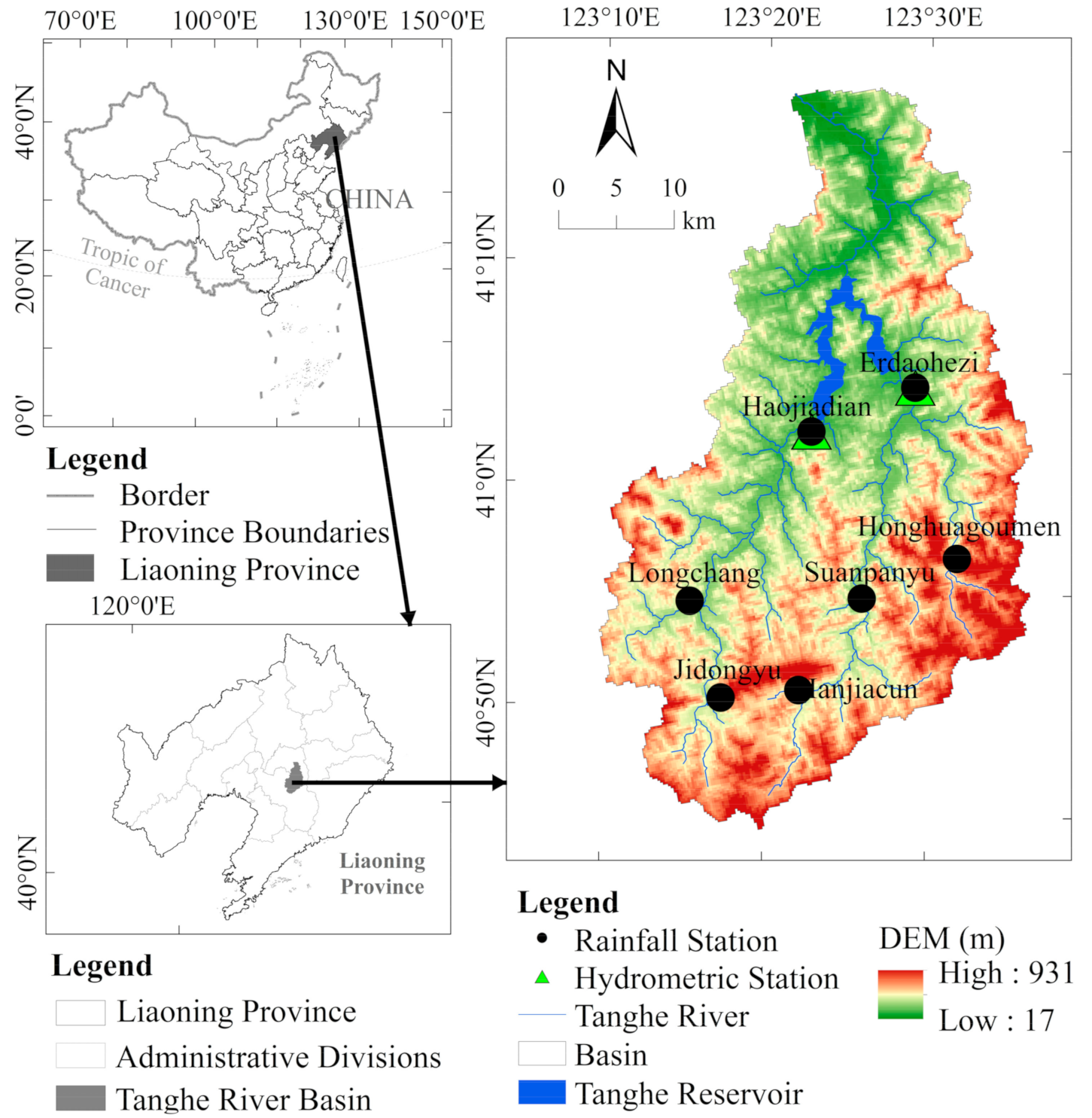
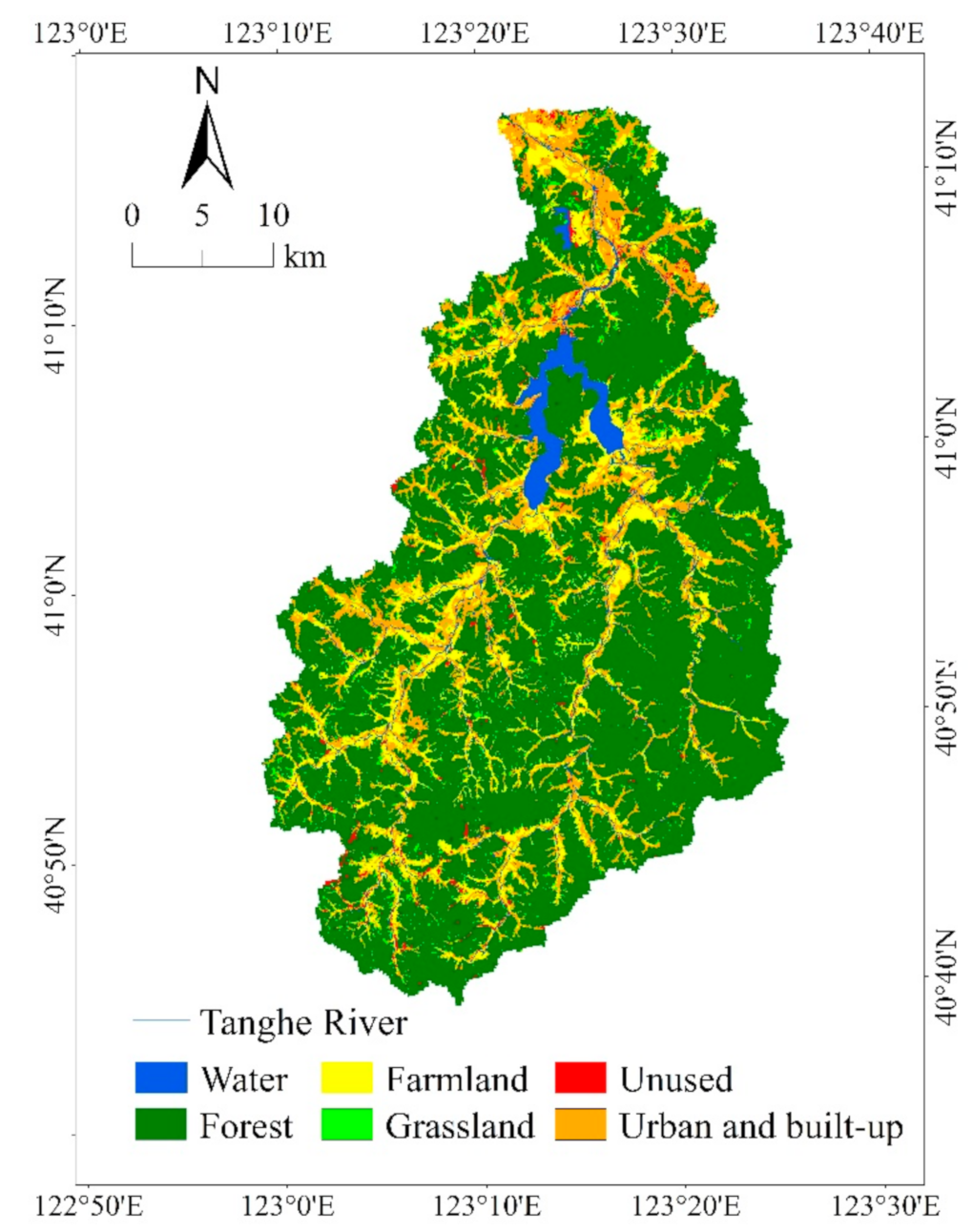

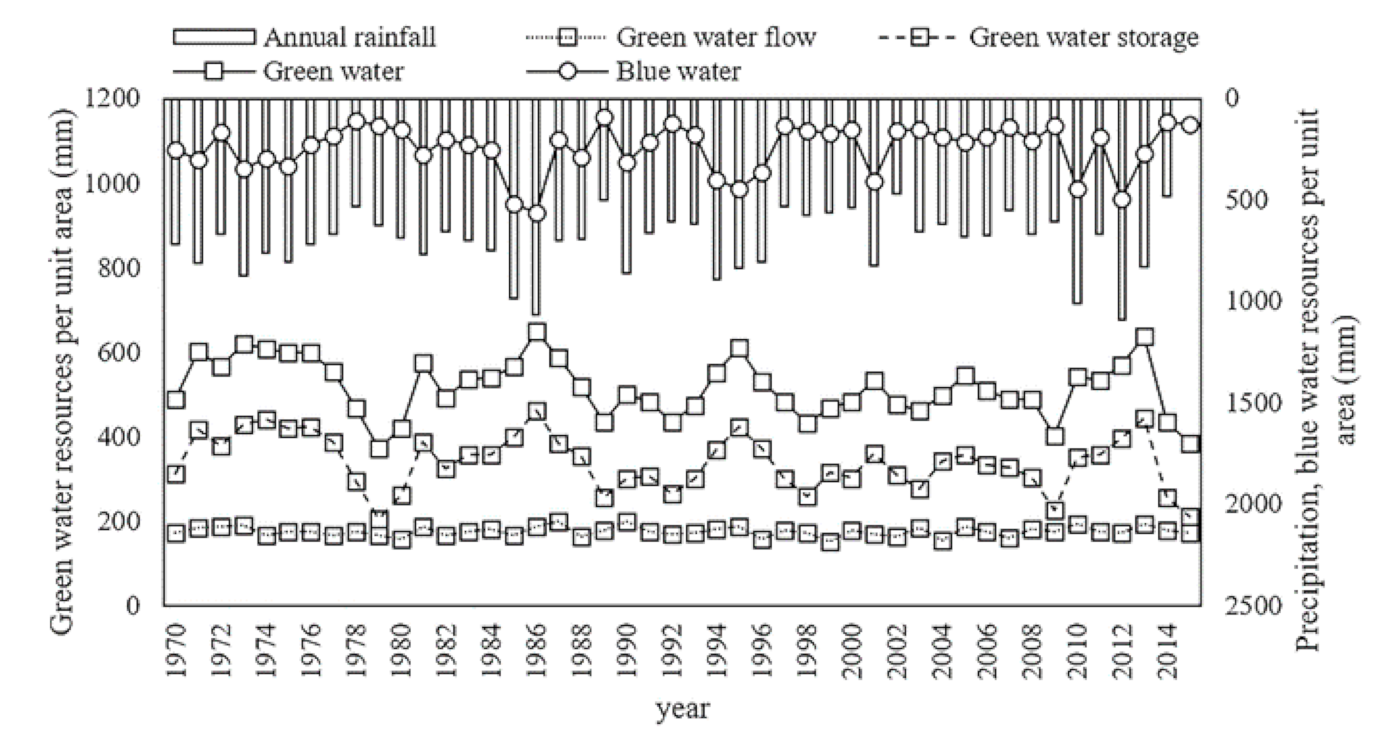
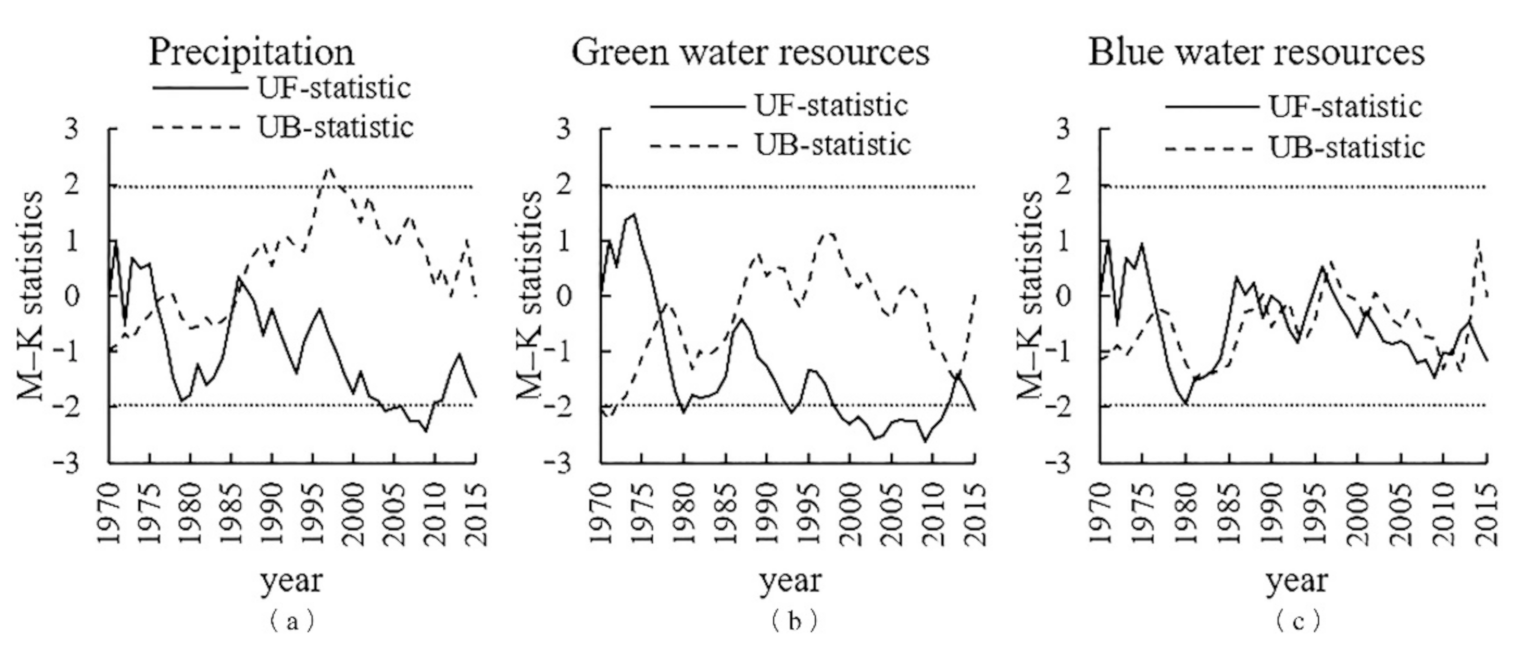
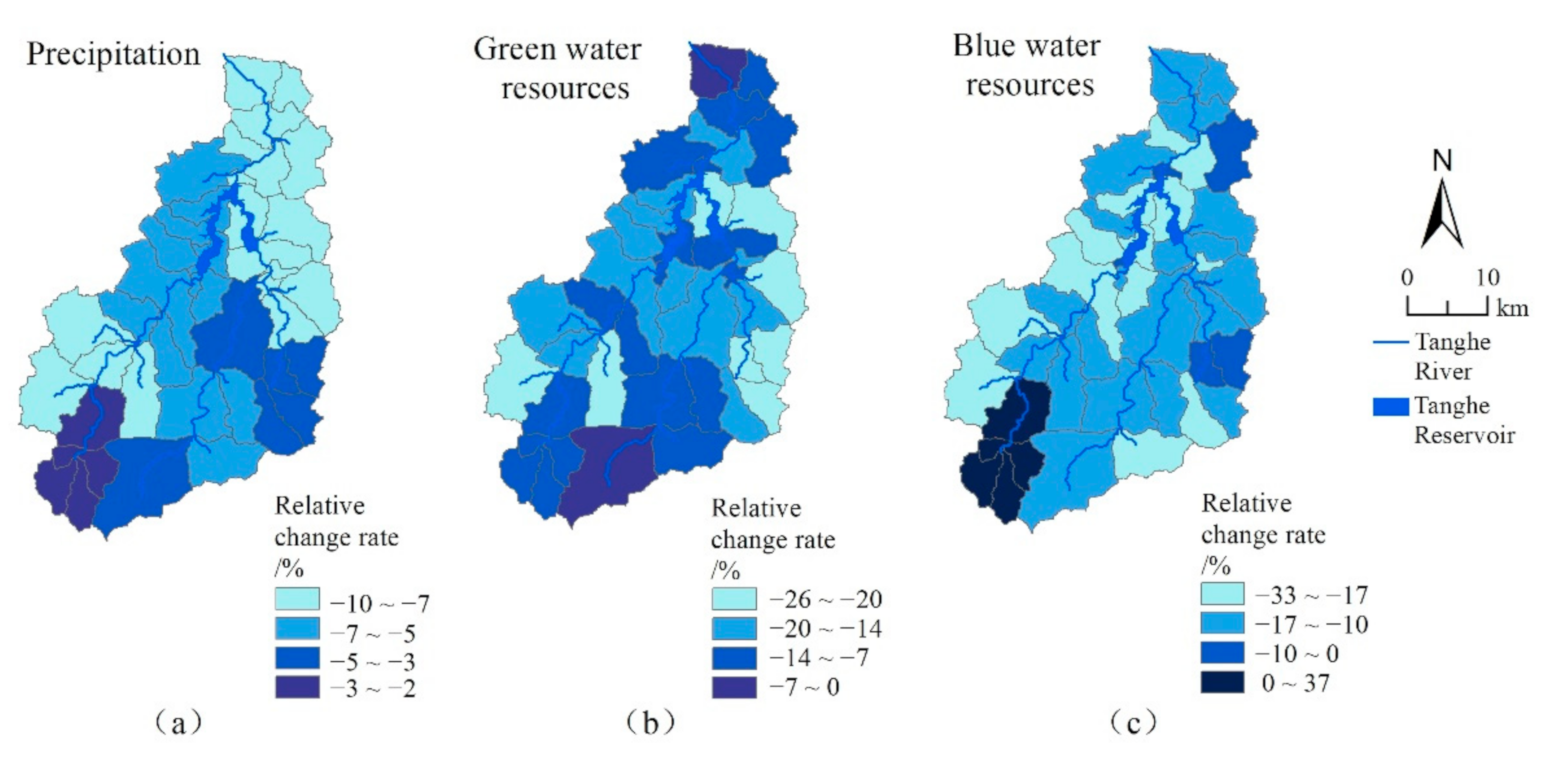
| Precipitation | Green Water | Blue Water | |
|---|---|---|---|
| Reference Period (1970–1976) (mm/year) | 763.71 | 583.36 | 273.02 |
| Variation Period (1977–2015) (mm/year) | 699.70 | 504.89 | 237.08 |
| Value of Change (mm) | −64.01 | −78.48 | −35.94 |
| Rate of Change (%) | −8.38 | −13.45 | −13.17 |
| River Basin | Climate Type | Precipitation (mm) | Green Water Coefficient (%) |
|---|---|---|---|
| Wuyuer River Basin | Temperate monsoon climate | 496.7 | 90 |
| Huangshui Basin | Plateau continental climate | 400–600 | 79 |
| Xihe River Basin | Temperate monsoon climate | 700–900 | 69 |
| Tanghe River Basin | Temperate monsoon climate | 763.71 | 68 |
Publisher’s Note: MDPI stays neutral with regard to jurisdictional claims in published maps and institutional affiliations. |
© 2021 by the authors. Licensee MDPI, Basel, Switzerland. This article is an open access article distributed under the terms and conditions of the Creative Commons Attribution (CC BY) license (http://creativecommons.org/licenses/by/4.0/).
Share and Cite
Jiang, J.; Lyu, L.; Han, Y.; Sun, C. Effect of Climate Variability on Green and Blue Water Resources in a Temperate Monsoon Watershed, Northeastern China. Sustainability 2021, 13, 2193. https://doi.org/10.3390/su13042193
Jiang J, Lyu L, Han Y, Sun C. Effect of Climate Variability on Green and Blue Water Resources in a Temperate Monsoon Watershed, Northeastern China. Sustainability. 2021; 13(4):2193. https://doi.org/10.3390/su13042193
Chicago/Turabian StyleJiang, Junchao, Leting Lyu, Yuechi Han, and Caizhi Sun. 2021. "Effect of Climate Variability on Green and Blue Water Resources in a Temperate Monsoon Watershed, Northeastern China" Sustainability 13, no. 4: 2193. https://doi.org/10.3390/su13042193
APA StyleJiang, J., Lyu, L., Han, Y., & Sun, C. (2021). Effect of Climate Variability on Green and Blue Water Resources in a Temperate Monsoon Watershed, Northeastern China. Sustainability, 13(4), 2193. https://doi.org/10.3390/su13042193






